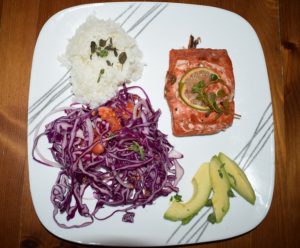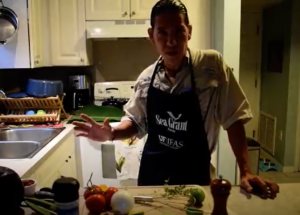This month we start another season of Seafood at Your Fingertips LIVE, and I volunteered to start the season by preparing a Latin-American influenced dish – grilled fish wrapped in banana leaves. There are many reasons why I chose this dish, but the main one is that this month from September 15th to October 15th, we celebrate National Hispanic Heritage Month. Cooking is a great way to celebrate the histories, cultures, and contributions of Hispanics to this country.

Bananas are not native to this continent but to tropical Asia. However, after being introduced in the early 16th century by Europeans, bananas were rapidly adopted and became an important food product throughout Latin America. Banana leaves are not edible but have been incorporated in the preparation of some of the most fascinating and delicious dishes, including Mexican tamales, Nicaraguan nacatamales, Puerto Rican guanimes, and others.
Banana leaves are great to use in slow cooking as well as fast, high-intensity recipes like this one. They provide a unique flavor, prevent food from dehydrating by keeping steam in, and just look cool.
A true Latin American condiment that I use is achiote paste also known as “achiote”, this ingredient is made out of achiote “annatto” seeds plus other species. Achiote is normally used as a natural food coloring, as a condiment and to bring aroma to many different dishes from Mexico, Caribbean, Central American and South American countries.
For this recipe, I used Mahi-Mahi (Coryphaena hippurus), also known as dolphinfish or dorado. In fact, in Latin, the species’ name “hippurus” means gold-fish, which is “dorado” in Spanish.
This species inhabits warm, offshore waters and is one of my favorite marine fish. Mahi-mahi is a gorgeous fish with a very interesting life history. Mahi-mahis are strong, fast swimmers and they prey on squid and flying fish. While they do not live very long — only about 5 years — they are also very fast growers. In their relatively short life, they can reach up to 63 inches and weigh up to 80 pounds.
Mahi-mahi is lean and firm in texture and can be used in many different recipes. However, due to its high moisture content, I like to grill it wrapped in banana leaves. Mahi-Mahi is also a very healthy food choice, good source of protein (about 32 per 6 oz of fish), low in saturated fat and a good source of vitamin B12, phosphorus, and potassium.
How to watch
The grilled mahi-mahi wrapped in banana leaves cooking demonstration will take place at 6 pm EST on Wednesday, September 16th, via Facebook Live on the Florida Sea Grant Facebook page! If you cannot catch the demonstration live, all videos will be archived for future viewing at this page. I’ll be available live to answer your questions and respond to comments – I can’t wait to see you there!
How to cook along
This recipe is easy, so if you want to cook along you can. Just check out the ingredients list below and make sure you have what you need. You will also need to have your grill ready to go. You will want to set up your grill for medium-high heat, which is about 400F degrees (205C). If you are using a charcoal grill, it will take 10 to 15 minutes to achieve this temperature. Coals should be glowing bright orange with a faint layer of ash.

The ingredients below will yield 4 servings of grilled mahi-mahi, though the number of servings depends on the size of the fish filets that you use.
For the fish:
- 4 small fish fillets about 8 oz each
- ¼ cup of olive oil
- 1 tbsp of lime juice
- ¼ cup of orange juice
- ¼ cup of white vinegar
- ½ tablespoon of coarse salt
- ½ cup of achiote paste (paste of annatto seeds)
- ½ tablespoon of black pepper
- 2 or 3 limes
- 2 cloves of garlic – chopped
- Mexican oregano (dry or fresh leaves)
- Banana leaves – about 4 pieces (one foot by one foot)
- Wooden toothpicks – six inches or longer
Instructions:
- Set up the grill for medium-high heat (400F or 205C).
For the marinade:
In a bowl, combine achiote paste with white vinegar, lime and orange juice, , coarse salt, garlic, Mexican oregano, and black pepper. Set aside.
For the fish:
Make sure that your fish is dry. If it isn’t, use paper towels to pat it dry. Place the fish in the bowl with the marinade, and let it rest from 15 minutes to one hour.
For the banana leaves:
Clean them well with a wet rag if the leaves are from your garden. If you bought them at the store, they are probably ready to use. If leaves are fresh, please tune in so you can learn how to prepare them so they will not break once you wrap your fish in them.
A whole banana leaf was enough to obtain 4 pieces (one foot by one foot) to wrap the mahi-mahi.
You will use the wooden toothpicks to secure the banana leaf.
When ready to grill:
Remove fish from the marinade. Place each piece of fish on a piece of banana leaf then add a lime wheel and a few leaves of Mexican oregano on top. Wrap the fish in the leaf and secure with a wooden toothpick by weaving it through the ends. Grill the leaf-wrapped fish for about 10 to 15 minutes. Make sure the side with the toothpick is facing up, it makes the handling of the wrapped fish easier, prevents the toothpick from burning (in case your grill temperature is too hot), and prevents potentially losing some mahi-mahi into your coals.
To serve:
Serve the fish in the banana leaf or unwrapped along with white rice and a salad.
For more information:
After the presentation on Wednesday, a recipe card with more information about the biology of Mahi-Mahi and regulations will be posted in our page.
 1
1
